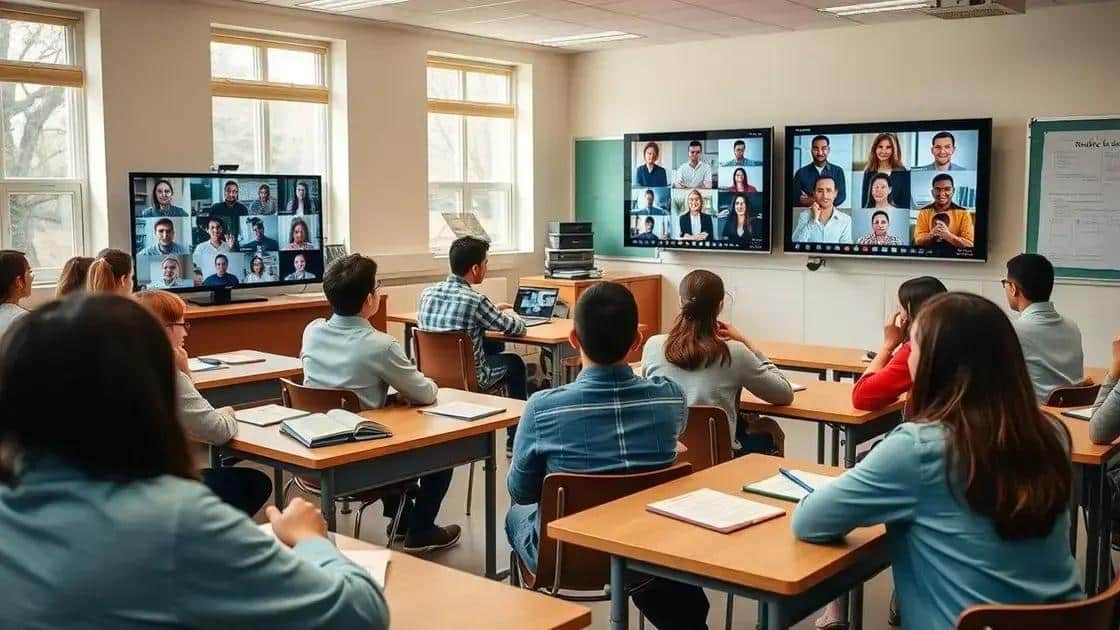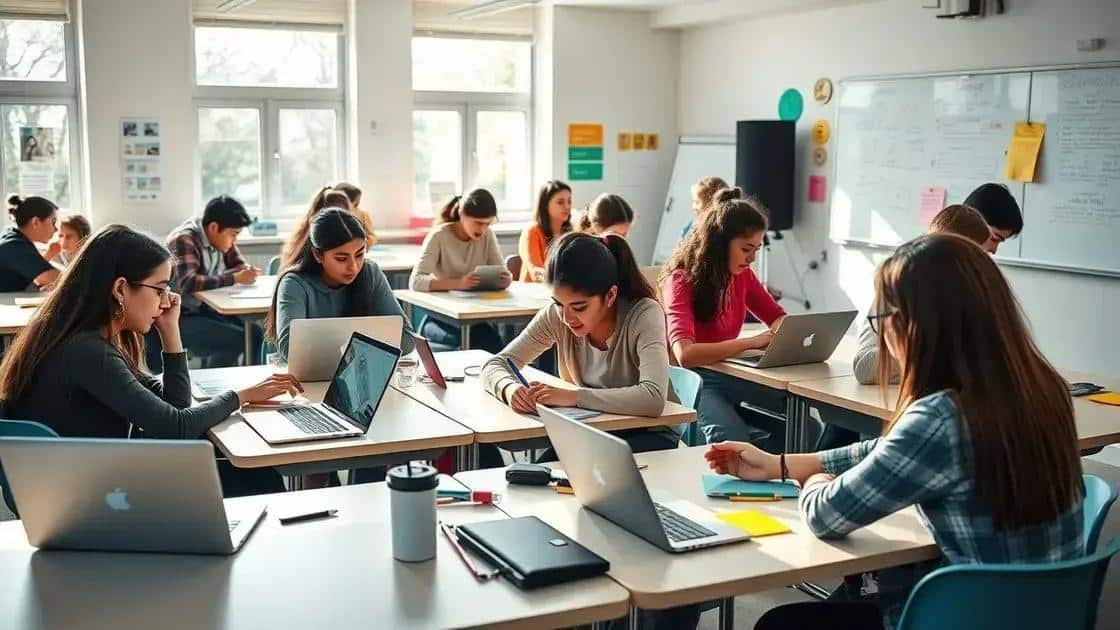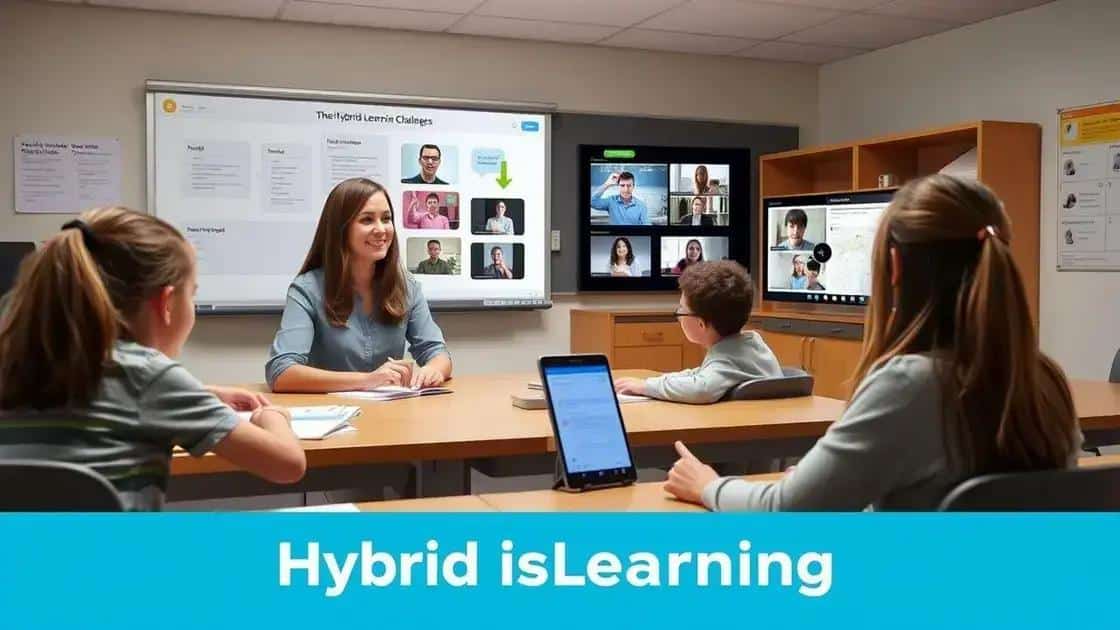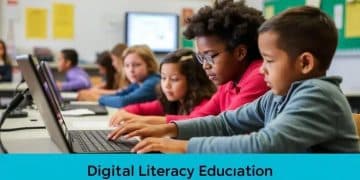Hybrid learning success trends: what works and why

Hybrid learning success trends involve implementing effective strategies such as ensuring technology access, engaging students through interactive tools, and adapting teaching methods to meet diverse learning needs.
Hybrid learning success trends are reshaping education as we know it. With a blend of in-person and online methods, it’s worth exploring what really makes this approach effective. Ever wondered how these trends can enhance your learning experience?
Understanding hybrid learning environments
Understanding hybrid learning environments is crucial for educators and students today. These environments combine both in-person and online learning, creating a flexible and dynamic approach to education.
One of the key elements of a successful hybrid learning model is its adaptability. This means that educators can tailor lessons to meet the needs of different learners. When students can access materials online, they can learn at their own pace, ensuring that no one gets left behind.
Benefits of Hybrid Learning
The flexibility and accessibility of hybrid learning offer numerous benefits. Here are a few:
- Personalized learning: Students can choose when and how they complete their assignments.
- Increased engagement: Interactive online tools can make learning more engaging.
- Broader access: Students from different locations can participate in high-quality education.
Moreover, effective communication between teachers and students in hybrid settings enhances collaboration. Regular check-ins and feedback help to create a supportive learning atmosphere. This approach fosters a community where students feel connected, regardless of their physical location.
Challenges in Hybrid Learning Environments
While many advantages exist, some challenges come with hybrid learning. Students may struggle with distractions in their learning environments, both online and offline.
Furthermore, ensuring all students have equal access to technology can be a significant barrier. Schools need to invest in resources to support their students’ needs effectively. With the right strategies in place, these challenges can be addressed successfully, paving the way for a more inclusive educational experience.
In conclusion, understanding hybrid learning environments involves recognizing their benefits and challenges. When implemented thoughtfully, these environments can enrich the educational landscape, making learning accessible and engaging for all.
Key strategies for successful hybrid learning

Key strategies for successful hybrid learning help educators create effective and engaging learning experiences. Embracing technology is crucial, as it bridges the gap between in-person and online instruction.
One effective approach is to ensure that all students have access to reliable technology. This can involve providing devices for those who don’t have them. By doing so, students can participate fully in hybrid classes, regardless of their location.
Engaging Learning Activities
Another important strategy focuses on designing engaging learning activities. These activities should encourage interaction among students. For instance, group projects can be conducted in smaller teams, allowing students to collaborate efficiently.
- Use multimedia: Incorporate videos, podcasts, and interactive quizzes to enhance engagement.
- Encourage discussion: Facilitate online discussions through forums or video calls.
- Gamify learning: Introduce game elements to motivate students and make learning fun.
Additionally, providing clear instructions and expectations is essential in a hybrid learning environment. Students benefit from understanding their tasks and deadlines. Regular check-ins can help keep them on track, reducing feelings of isolation.
Feedback and Assessment
Timely feedback is a key component of successful hybrid learning. Teachers should offer constructive comments on assignments and encourage students to reflect on their work. This process promotes growth and helps students improve their skills.
Moreover, utilizing a variety of assessment methods can enhance learning. Quizzes, polls, and written reflections allow students to demonstrate their understanding in different ways. By diversifying assessments, educators can cater to various learning styles, making the learning process more inclusive.
Overall, implementing these key strategies can significantly enhance the effectiveness of hybrid learning. By focusing on accessibility, engagement, and feedback, educators can create enriching experiences that foster student success.
Measuring success in hybrid learning
Measuring success in hybrid learning is essential for both educators and students. Understanding how to effectively evaluate learning outcomes can improve the educational experience.
One way to measure success is through student engagement. Tracking participation in both online and in-person activities provides valuable insights. Educators can use tools like surveys or analytics from learning management systems to assess engagement levels.
Assessment Techniques
There are various assessment techniques to gauge learning in a hybrid environment. Utilizing different methods ensures a comprehensive understanding of student progress.
- Formative assessments: Frequent quizzes and interactive polls help monitor progress more dynamically.
- Summative assessments: These include final projects or exams that evaluate overall learning at the end of a course.
- Peer evaluations: Allowing students to assess each other’s work encourages collaboration and critical thinking.
Feedback also plays a key role in measuring success. Offering timely and constructive comments helps students identify their strengths and weaknesses. It creates a dialogue that encourages improvement and boosts confidence. Educators must ensure feedback is clear and actionable, guiding students on how to enhance their performance.
Long-term Success Indicators
In addition to immediate assessments, long-term metrics are important. Tracking students’ progress over time provides a deeper understanding of their learning journeys. Metrics like retention rates and course completion rates are valuable indicators of success in a hybrid setting.
Moreover, student satisfaction surveys can provide insights into the effectiveness of hybrid learning. Gathering opinions on courses, teaching methods, and technology used enriches the learning framework. By focusing on what students find beneficial, educators can refine their approaches and strategies.
Ultimately, measuring success in hybrid learning involves a combination of engagement tracking, diverse assessment methods, feedback, and long-term indicators. This holistic view is critical for creating effective learning experiences.
Challenges and solutions in hybrid learning

Challenges and solutions in hybrid learning are crucial topics for educators navigating this blended approach. While hybrid learning offers flexibility, it also presents unique hurdles that must be addressed effectively.
One common challenge is ensuring that all students have access to necessary technology. Not every student may have a laptop or a stable internet connection. Schools need to consider providing resources such as devices or creating partnerships with local businesses to offer internet access.
Creating Engagement
Another significant challenge is maintaining student engagement. In a traditional classroom, teachers can easily interact with students, but in hybrid learning, this can be more difficult.
- Utilizing interactive tools: Platforms like Kahoot or Quizlet can make learning more engaging.
- Encouraging collaboration: Group projects can foster teamwork, whether students are in-person or online.
- Regular check-ins: Scheduled one-on-one or small group discussions can help keep students accountable.
Furthermore, some students may feel isolated when learning online. Building a sense of community is essential in addressing this issue. Incorporating icebreakers and social activities in the course can make a difference. Establishing group norms and encouraging open communication also help students feel connected.
Adapting Teaching Methods
Teachers must adapt their teaching methods to suit both in-person and online learners. This dual approach can be challenging, as not all teaching strategies work in both environments.
For instance, hands-on activities can be difficult to translate into an online format. Teachers can overcome this by providing alternative options that encourage students to engage with the material creatively. Using videos or virtual simulations can enhance understanding while catering to different learning styles.
In summary, although challenges arise in hybrid learning, there are numerous solutions available. By addressing technology access, fostering engagement, building community, and adapting teaching methods, educators can create effective hybrid learning environments that benefit all students.
FAQ – Frequently Asked Questions about Hybrid Learning
What are the main challenges of hybrid learning?
The main challenges include ensuring access to technology, maintaining student engagement, and adapting teaching methods for different environments.
How can educators enhance student engagement in hybrid settings?
Educators can use interactive tools, encourage group projects, and hold regular check-ins to keep students engaged.
What assessment methods work best in hybrid learning?
A mix of formative assessments, summative assessments, and peer evaluations can effectively gauge student understanding in hybrid learning.
How can technology improve hybrid learning experiences?
Technology helps bridge the gap between in-person and online instruction, making resources accessible and facilitating communication among students.





